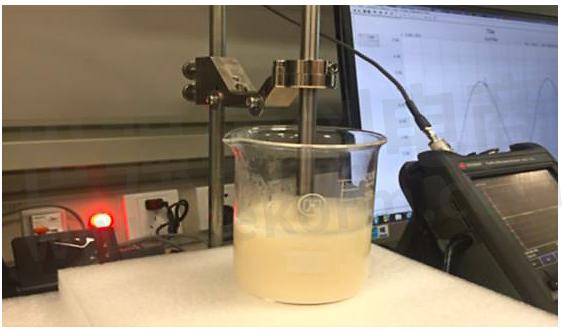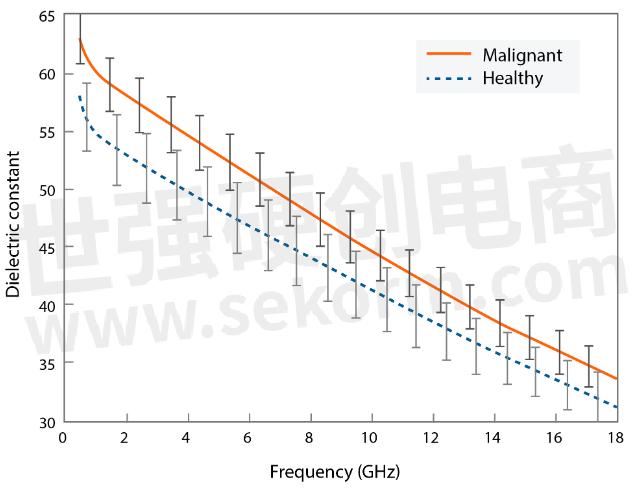A New Method for Early Breast Cancer Detection: Handheld RF Analyzers

Breast cancer, the most common cancer in women worldwide, is a disease that hits close to home for most. One doesn’t have to look hard to see its effects in communities around the globe. From 2008 to 2018, breast cancer incidence rates increased by more than 20% worldwide and mortality rates increased by 14%. While incidence rates are highest in developed regions, mortality is highest in less-developed countries that lack early detection and access to treatment. As the American Institute for Cancer Research states, “With this growing global burden, prevention of cancer is one of the most significant public health challenges of the 21st century.”
Recently, researchers tried out a new method for cancer detection involving Handheld RF Analyzers. The method involves measuring the difference between the dielectric constants of normal breast tissue and cancerous tissue. Figure 1 shows the test setup.
Figure 1. The test configuration including a coaxial probe, a tissue sample, a handheld analyzer, and materials measurement software on a PC
In simple terms, the dielectric constant of a material is a complex number that represents the response of a dielectric material to an electric field. The larger that number is, the stronger the material couples with an RF pulse. Researchers testing cancerous tissues at different frequencies found that cancerous tissues consistently produce higher dielectric constant values than normal tissue. Figure 2 shows the dielectric curves of both tissues.
Figure 2. Dielectric constant curves of cancerous and normal tissues measured at different frequencies
Having access to a portable network analyzer that performs S-parameter measurements of the dielectric constants of different materials is beneficial for medical students, researchers, doctors, and patients. Medical students gain a better understanding of S-parameter RF measurements while also performing materials testing. Researchers make use of a single, portable device that performs multiple measurements instead of purchasing several different types of bench-top equipment for varying lab tests. Doctors ensure that patients receive early analysis and timely treatment potentially earlier than traditional detection methods.
The lightweight and flexible design of a handheld analyzer, such as Keysight's FieldFox, makes it convenient and easy to operate in practical laboratory applications. In addition to enabling the teaching of materials testing in groups, a handheld analyzer like FieldFox, paired with Keysight's N1500A materials measurement software, verifies the feasibility of dielectric constant imaging. FieldFox handheld analyzers are not only accurate and reliable, but their flexibility allows users to configure them as a cable and antenna analyzer, a vector network analyzer, a spectrum analyzer, or a combination analyzer.
Find out more about RF analyzer use in cancer detection and other medical applications in the white paper "Innovative Use Cases for Handheld Analyzers in the Medical Field."
- +1 Like
- Add to Favorites
Recommend
- Keysight FieldFox Handheld Microwave Analyzer Speeds Installation of 5G, Radar and Satellite Communication Systems
- Keysight FieldFox Handheld Analyzers Now Supports EMI Pre-Compliance Measurements
- 6 Essential 5G Field Tests
- Keysight Introduces Software-Defined Handheld Analyzer N9912C
- Keysight Technologies Acquires Quantum Benchmar, Augmenting Keysight‘s Quantum Portfolio
- Keysight First to Gain GCF Approval of Cases for Validating 5G New Radio mmWave Devices in Standalone Mode
- Keysight and Transphorm Create Power Supply Reference Design that Lowers Product Costs; Speeds Time to Market
- Deviser Debuts Combined Spectrum, Cable Analyzers with Fiber Test for Handheld Wireless Test and Measurement
This document is provided by Sekorm Platform for VIP exclusive service. The copyright is owned by Sekorm. Without authorization, any medias, websites or individual are not allowed to reprint. When authorizing the reprint, the link of www.sekorm.com must be indicated.
































































































































































































































































































































































































































































































































































































































































































































































































































































































